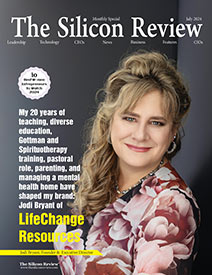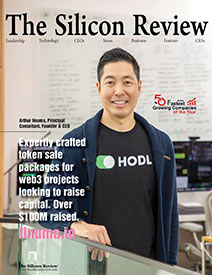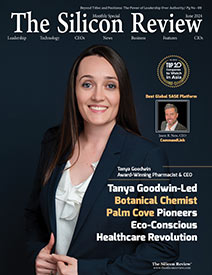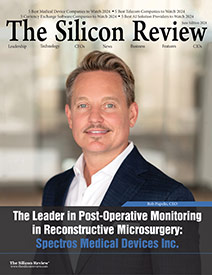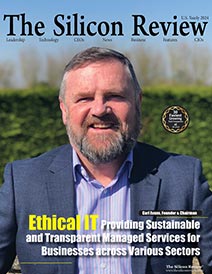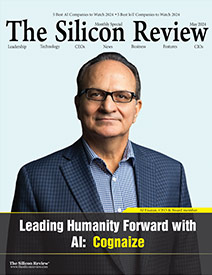Greg Waters, MatrixSpace Co-Founder: “We’re experts in Software Defined Sensing and Autonomous Systems. Our sensing dramatically extends our human five senses, and our Automated systems allows us to greatly extend the range and effectiveness of our responses. This is the next wave of productivity between people and intelligent machines”.
The Silicon Review
![]()
In the near future, many industries will be transformed by new work practices between people and intelligent machines. Smart sensors, vehicles, drones, and automation, in general, are reinventing industries as diverse as safety & security, defense, construction, and insurance. MatrixSpace was founded in 2019 to create the technology needed for people to elegantly control groups of smart machines and to leverage the best of human and artificial intelligence. A single user can see what groups of other people or machines are sensing and to direct automated behavior in response. Their first product family is DopplerSpace, an AI software platform that dramatically extends the human five senses. Optical camera and other sensor information are combined with unique ultra-low-cost radar information, and this combination allows us to “see” in the dark, at a distance, and in bad weather, smoke, or fog. DopplerSpace allows any number of fixed, mobile, or aerial sensors to rapidly detect what is around them -- and display that in an intuitive way to a person or a team of people. The ShannonSpace software platform significantly extends the range and speed of human response. ShannonSpace makes drones, vehicles, or other machines very smart and allows people to direct high-level tasks that these smart machines carry out largely on their own. This combination of AI sensing and AI automated response extends human capabilities in meaningful ways. For instance, a safety or security situation may be detected by DopplerSpace AI-Sensors; automated drones fly on their own to create a real-time model of the area of interest. An operator can then rapidly assess the situation from afar using highly detailed 3D depictions of an area that are more detailed than we could see -- even if we were standing there.
Large outdoor areas or structures can now be rapidly surveyed in 3D to detect safety issues such as stress cracks, building code conformance, or excessive heat. This saves enormous amounts of time and improves the safety of work crews that would normally be doing this manually. Birds can be detected and chased away from airports. Construction and insurance businesses can assess structural integrity in hours instead of weeks. Defense applications can leverage wearable or handheld sensors coupled with vehicles and drones to create highly accurate “perception bubbles” that move and update on the fly. Autonomous response or direction of drones and other ground assets allow people to concentrate on major mission objectives and not spend time gathering information. Safe entrance and exits are greatly improved for teams traversing an unknown area. A novel approach taken by the MatrixSpace team is to deliver an open architecture for AI. AI computing is done on low cost popular computing hardware, which can be run locally or on any major cloud platform. Many popular sensor types are already used, and more can be added. The approach toward incorporating AI neural networks, or algorithms, is very different than conventional approaches. Rather than provide customers with a closed proprietary system, the MatrixSpace architecture captures AI algorithms of their own making, along with those from 3rd parties.
Their objective is to create the first open ecosystem for AI that people use to perform tasks, with announcements to be made later this year on key industry partnerships. The goal is to have a dynamic and expanding collection of new AI skills and provide a business model where AI innovators can be paid for their inventions.
We sat down recently with Greg Waters, who Co-Founded MatrixSpace along with Dr. Jose Martinez Lorenzo of Northeastern University.
Q. What motivated you to start MatrixSpace?
We wanted to create a platform that put intelligent machines to work for average people. There’s no elegant platform today that allows ordinary people to have groups of smart machines to perform useful tasks. We felt that this was important for many industries but also for the quality of life of working people in general. So our slogan became “Connecting People and Intelligent Machines.” It’s a very different way of combining the best aspects of human and artificial intelligence.
Q. Can you explain about your AI solutions in brief?
Our AI includes people as part of the system since there are many things that people will always do better than AI computing and vice-versa. We’re experts on what we call a dynamic mesh network, and this connects people, drones, vehicles, and sensors and allows each to influence decision making. Our DopplerSpace software platform greatly extends the human five senses – our machine learning processes optical, radar, and other sensor type information into a single, intuitive user interface. Optical cameras are great, but they allow us to see only as well as we can with our eyes. When the AI adds new sensor information that we can’t see, such as radar, lidar, thermal, and more – it’s like being able to see in the dark, at long distances, and with a level of detail that we can’t see on our own.
![]()
Once we’ve extended what people can sense, the next thing is to extend the range and response time of what people can do. This is where the AI autonomous flight comes in – our software works on practically any smart machine, but most of our work is with smart drones. Our ShannonSpace AI software platforms create intelligent “swarms” – a person with a tablet can use their finger to draw a line around an area and tell the drones to go find a specific object, or to chase birds away, or to deliver a set of packages. People remain in charge but don’t have to be expert drone pilots to do useful things.
Q. What are the different sectors that your company is focusing on with AI Sensing and Autonomous flight solutions?
Great question, since technology can transform many industries. Our initial focus will be on Safety & Security for both Enterprise businesses and Defence since we can quickly make a profound difference in physical safety. Other industries on our roadmap include Construction, Insurance, and transportation.
Q. Despite the growing interest in autonomous flight, understanding users’ perceptions to it remains limited. How do you address this challenge?
The approach to automated flight so far has been oriented toward niche applications or hobbyists. We don’t have a consumer focus – what will expand the usage model is when autonomous flight makes existing business models just work better. So we focus on doing existing applications a lot faster, cheaper, and better – and that’s just good business.
Q. What are the anticipated trends in AI Sensing and autonomous flight?
Every business or government operation we speak to wants to significantly increase physical safety and security. Our AI sensing capability does that at a price/performance point that is compelling. Once you have that, it’s a small step to layer on additional types of AI-enabled response capabilities. Some of those will include smart drones, but all of them use the AI to make our response time faster and more accurate.
Q. What would you say are the top three skills needed to be a successful CEO?
CEOs have three primary missions, which are to care for their employees and help them grow; to solve customer problems so well that they can’t live without you, and to increase value for investors. Of these three things, if you get the first two right then the investor value tends to follow nicely.
Q. What other CEOs do you look up to? Why?
I’ve been lucky to know some great CEO’s and leaders at many levels. I think every employee is a CEO in a real fashion. I look up to people that inspire others to accomplish seemingly impossible things, and have some fun while doing it.
Q. How do you market your services?
We market direct to major companies, and so far they have been finding us. There aren’t many teams that can do this, and with the skilled labor shortages that we visible everywhere, companies are looking for new ways to do things, and to do them better.
Q. Do you have any new services ready to be launched?
Of course! But we’re not going to tell you since that would take away the fun part. Between this year and next, you’ll see a number of systems deployed that really demonstrate how a handful of people can do what would have taken a much larger group and three shifts to pull off.
Q. What does the future hold for your company and its customers? Are exciting things on the way?
In less than five years, we’re going to completely change the way that ordinary people think about how they can work with groups of smart machines. This is going to change everything – these smart machines will become extensions of us. It will re-invent large existing industries and enable some new entrepreneurial ones too.
Q. What sets up MatrixSpace to do this differently than others?
One of the reasons why there are so few examples of putting AI tech to work for people is that the problem set is very cross-functional – you need innovation with RF & Radars, with sensor fusion, which is basically really complicated mathematics, with automated flight software, and with the core AI training and inference itself. All of these things need to come together in an elegant system that is easy to use, but the skillsets required for each are very different. We’re proud to have world-class talent in each of these areas, and we had the opportunity to start with a blank sheet of paper on how we implemented all of this. We think we have the first open architecture that will enable a lot of applications, people, and businesses. It will be an exciting journey and a lot of fun.




